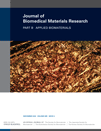Characterization of hydroxyapatite-perovskite (CaTiO3) composites: Phase evaluation and cellular response
Abstract
In this study, an attempt was made to develop an understanding of the densification behavior, phase stability, and biocompatibility property of HA-CaTiO3 biocomposite. The composites with varying CaTiO3 (40–80 wt %) content were sintered at temperatures ranging from 1200°C to 1500°C for 3–5 hr to establish optimum processing parameters. The phase analysis using spectral techniques indicate good thermochemical compatibility between HA and CaTiO3. The microstructural observations reveal homogeneous distribution of finer CaTiO3 phase (1–2 μm) along with coarser calcium phosphate phase. In vitro cell culture studies using L929 mouse fibroblast and SaOS2 human osteoblast cell lines provide clear evidence of cell adhesion, spreading, and proliferation as well as the formation of cellular bridges, and, hence, good in vitro biocompatibility of the developed composite can be realized. Also, the number of viable cells was found to increase with incubation period, as revealed by statistical analysis of the 3(4,5-dimethylthiazol-2-yl)-2,5-diphenyltetrazolium bromide assay data. © 2010 Wiley Periodicals, Inc. J Biomed Mater Res Part B: Appl Biomater, 2010.




